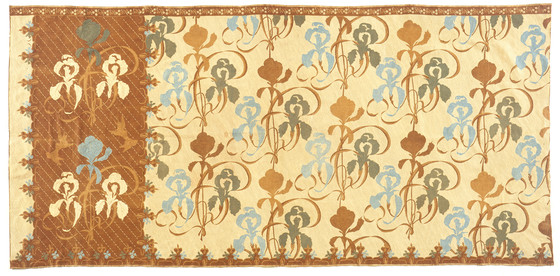Hip wrapper, m.91.184.392
Overview
...
Hip wrapper, m.91.184.392
Overview
Excerpted from Herina, Rens, and Harmen C. Veldhuisen. Fabric of Enchantment: Batik from the North Coast of Java. Los Angeles: Los Angeles County Museum of Art; New York: Weatherhill, Inc., 1996, Catalogue no. 22.
On the badan of this beautiful batik large irises in soft blue, green, and tawny are combined with elegantly curling leaves in a design that reveals an art nouveau source. Perfectly executed galaran cover the beige background, here used as a purely decorative device. In the kepala two sets of clustered irises and pairs of flirting swallows decorate the dark brown ground marked with diagonal nitik lines. The border design follows the Indo-European asymmetrical division: the upper consists of a variation on the simple floral band; the lower is embellished with clusters of small orchids, but in perfect accordance with the rest of the design. Note the extra space next to the kepala, permitting the entire kepala to remain visible when worn.
Maker
This batik, signed “J. Jans,” was made in the workshop of A. J. F. Jans. The design is probably after the English artist William Morris (1834–96), a founder of the arts and crafts movement. It may have been copied from a magazine; Indo-European entrepreneurs used these and other art nouveau sources, such as books and postcards. The batik must have been made around 1900, when Jans ceased signing herself as the widow of Th. J. Jans. The style here, with diagonal lines in the background of the kepala (an adaptation of a design by Lien Metzelaar no earlier than c. 1880), is later than those made bearing the signature “Wed. J. Jans.”1
The flower in the lower border is an orchid, not an iris, a possible misreading of the original source by the hired drawer. The same error often occurred as daffodils were transmogrified into orchids.
Wearer
This very expensive cloth of the finest quality would only have been chosen by a mature woman with a fashionable and quite personal Europeanized taste. Only a lady whose husband was of high status could afford to make such a striking choice. The European iris stands for opulence; its fragrance, for happiness and the fullness of life.2 In the archipelago the flower may have been mistaken for an orchid, a flower that to Europeans represents graceful elegance.3 As the Javanese link the orchid with regeneration, it was and is often used in wedding bouquets or as decoration of the nuptial chamber. The Peranakan relate it to summer and the mature phase of life.
Notes
1. H. C. Veldhuisen, Batik Belanda 1840–1940 (Jakarta: Gaya Favorit, 1993), nos. 38–39.
2. De Echo: Weekblad voor dames in Indië (1900–1901): 454.
3. Jean Chevalier and Alain Gheerbrant, Dictionnaire des Symboles (Paris: Robert Laffont/Jupiter, 1988), 524, 708.
More...
